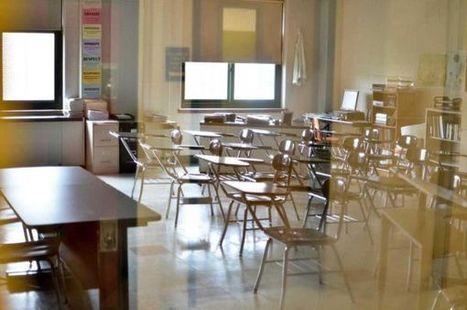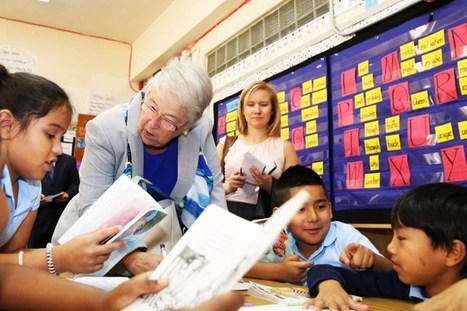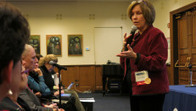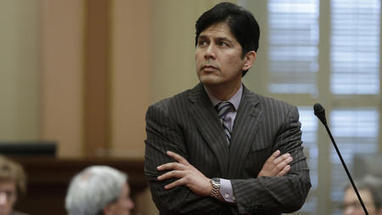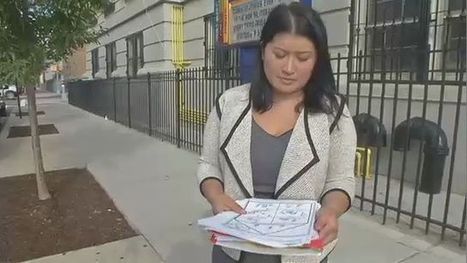 Your new post is loading...
Published by UNESCO, October, 2014
It is estimated that, if nothing is done, half of 6000 plus languages spoken today will disappear by the end of this century. With the disappearance of unwritten and undocumented languages, humanity would lose not only a cultural wealth but also important ancestral knowledge embedded, in particular, in indigenous languages.
However, this process is neither inevitable nor irreversible: well-planned and implemented language policies can bolster the ongoing efforts of speaker communities to maintain or revitalize their mother tongues and pass them on to younger generations.The aim of UNESCO’s Endangered Languages Programme is to support communities, experts and governments by producing, coordinating and disseminating :
tools for monitoring, advocacy, and assessment of status and trends in linguistic diversity,
services such as policy advice, technical expertise and training, good practices and a platform for exchange and transfer of skills.

|
Scooped by
Dual Language Education of New Mexico
October 23, 2014 12:16 AM
|
Published by Newsday, October 22, 2014
That first dual-language class is graduating from high school this year. One of the boys whose parents spoke only a little English is at the top of his class. Many kids from English-only homes continued with Spanish in high school and excelled.
Published by the Odessa American, October 19, 2014
Next session, I plan to file a bill that would provide a 25 percent add-on funding weight for ELL students. This won’t solve all of the problems with our current school finance system, but it will address one important facet that has been ignored for more than three decades. For far too long, we have been underfunding the language instruction that would benefit our children and our state immensely, and I plan to fight for a solution now.
Time and again, the Texas Supreme Court has found that the state isn’t meeting its obligation to our schools under the state constitution. In his ruling on the most recent school finance lawsuit, District Judge John Dietz wrote that the wide gap between expectation and actual performance in Texas “is even larger when considering the performance levels of economically disadvantaged and ELL student populations… Massive gaps also exist between ELL students and non-ELL students on every performance measure.”
While some argue that we cannot solve problems by “throwing money” at them, we clearly set our priorities through our budget. Further, when the problem is inequity in funding, we most certainly need to add more funding where it is needed. The bottom line is that our students deserve better, and our future success depends on it.
This is one of the reasons why, as chairman of the Senate Hispanic Caucus, I have been traveling around the state to visit with local community leaders and advocates. The other SHC members and I know that the state needs to do better on issues like education, health care, and economic opportunities for low- and middle-income Texans. Providing these opportunities will be better for all of us in the long run.
José Rodríguez is chairman of the Senate Hispanic Caucus and represents Texas Senate District 29, which includes the counties of El Paso, Hudspeth, Culberson, Jeff Davis, and Presidio.
Published by the Topeka Capital Journal, October 16, 2014
Meanwhile, USD 501 administrators are exploring options for a middle school dual-language site that will continue the bilingual education of students in the Spanish-English programs at Whitson and Scott elementaries.
Administrators have met with parents of the dual-language students and staff at a few middle schools to discuss the matter, and have recommended to the school board that the program be located at Landon Middle School.
Published by the NY Post, October 6, 2014
City Schools Chancellor Carmen Fariña and Milady Baez, the chief for “English-language learners,” are looking to increase dual-language programs, in which students receive instruction in both English and a second language.
This is bad news for the kids, and the city. I know from personal experience.
Published by Chalkbeat New York, October 1, 2014
Chancellor Carmen Fariña is fulfilling her promise to eliminate A-F letter grades for rating schools.
Her speech, her second major address as chancellor, focused on a revamp of how the city will measure schools’ success and present that information to parents. The centerpiece is a new framework for judging schools that takes community ties and teacher collaboration into account.
New state regulations require some districts that never had bilingual classes to put them in.
Minnesota's reforms to how their public schools serve dual language learners are exciting. A new brief explores their strategy for effective implementation.

|
Scooped by
Dual Language Education of New Mexico
September 28, 2014 1:24 PM
|
Published by Education Week, September 25, 2014
For the first time in the history of our nation, the majority of students enrolled in public schools are children of color. Yet the diversity in our teacher workforce remains stagnant. Roxana Norouzi shares her efforts to improve how teachers reflect student demographics in Washington state.

|
Scooped by
Dual Language Education of New Mexico
September 26, 2014 8:38 AM
|
The city must use its $25.9 billion budget to teach immigrant students English and not keep them tethered to its long-term bilingual programs — and a life of disadvantage — writes our columnist.

|
Scooped by
Dual Language Education of New Mexico
September 23, 2014 3:22 PM
|
Published by Ed Source, September 23, 2014
As accountability for student progress in California becomes more local, a new report focuses on how school districts can better educate their English learners – calling on administrators to embrace biliteracy, provide a rigorous curriculum and train all teachers in how to support language development in core courses, not just English language development classes.

|
Scooped by
Dual Language Education of New Mexico
September 18, 2014 6:15 PM
|
SB1174, passed by the California Legislature and now on the desk of Gov. Jerry Brown, undermines all the gains made during the past two decades in educating children who start school without a full knowledge of the English language.

|
Scooped by
Dual Language Education of New Mexico
September 18, 2014 3:53 PM
|
Published by Education Week
The Education Week Spotlight on Foreign Language Instruction is a collection of articles hand-picked by our editors for their insights on: - Building language-immersion programs
- Recognizing billiteracy with certifications in high schools
- Enrolling English-language learners in bilingual schools to encourage dual-language learning
- Encouraging students to study strategic languages, like Mandarin, Arabic, Korean, and Farsi
Elementary Pupils Immersed in Foreign Language Delaware and Utah are funding foreign-language instruction at the elementary level in hopes of fostering achievement and economic growth. November 30, 2012 - Education Week
Issue is billed as critical to help the United States compete in a global economy, and to better prepare today's young people for jobs after graduation. October 8, 2013 - Education Week Latino parents are increasingly sending their children to bilingual schools in an attempt to retain the family's Spanish-language fluency. Opponents of bilingual education say students in these programs don't perform proficiently in state tests. April 11, 2014 - Teaching Now
Biliteracy "seals" that recognize high school graduates with fluency in two or more languages are catching on in more states. July 8, 2014 - Learning The Language
Jared Diamond's new book argues that bilingualism and multilingualism can improve our health and wealth as a nation. December 14, 2013 - Global Learning
America's first public school to convert to a charter is still running strong--see how. August 10, 2013 - Global Learning
American disinterest in acquiring language skills to adapt to linguistic and cultural situations in which they find themselves is hurting an entire nation's likelihood of maintaining a predominant role in 21st century world matters. World interconnectedness coupled with the savvy of other world powerhouses has dictated that English is no longer the language needed to join the exclusive and elusive club of success and opportunity. July 3, 2014 - Global Learning
The real need is to produce students who can speak strategic languages such as Mandarin, Arabic, Korean and Farsi. October 21, 2013 - Walt Gardner’s Reality Check
|
Published by the Washington Post, October 24, 2014
Two languages, two sets of opinion about bilingualism. On the one side is the research that consistently shows that bilingualism is good for you. It leads to an enriched set of experiences, a new way of seeing the world, and more prosaically but no less importantly, is associated with reduced rates of dementia. People who are multilingual are perceived as more intelligent and educated, and they have better international contacts and resources in their careers.
On the other side, we also hear about the perniciousness of bilingualism among immigrants, the uselessness of supporting and preserving minority and indigenous languages, and the educational and economic harm that comes from ‘wasting’ valuable resources on bilingual education initiatives. Some even see maintaining another language as seditious, a compromise to national security, or at the very least, evidence of conflicted loyalties or identities, or that a person cannot be fully trusted.
These opposing views tells us more about stereotypes and social pigeonholing than about language. To put it bluntly, bilingualism is often seen as “good” when it’s rich English speakers adding a language as a hobby or another international language, but “bad” when it involves poor, minority, or indigenous groups adding English to their first language, even when the same two languages are involved.
Published bySil.org,October 21, 2014
Multilingual and bilingual education programs are most often a part of a formal educational system. For that reason, SIL has worked in cooperation with various ministries and departments of education in a variety of countries in program development.
Via Charles Tiayon
Published by the Tyler Morning Telegraph, October 16, 2014
The board received an update on planning for operation of the new career and technology center, which will house a wide variety of facilities from a high-end hair salon to television studio.
Information will be sent to parents and a pathway selection guide furnished, administrators said, also giving an update on hiring personnel.
In an unrelated presentation, Chief Academic Officer Dr. Christy Hanson updated the board on what is being done in response to a report that the board received in July from Gibson Consulting Group that evaluated the bilingual program last spring.
The consultants recommended Tyler ISD re-examine the bilingual model and English as a Second Language (ESL) model that it uses and determine whether it’s still appropriate and the best model for the district.
The district uses a late exit subtractive bilingual model of bilingual education.
That means students receive most of their instruction in their native language in prekindergarten and kindergarten with some introduction of English, but less and less of their native language is used and more English language is used as they progress until they are getting all their instruction in English in fifth grade.
The district has formed a steering committee of teachers, principals, parents and administrators to determine if that model is still appropriate, Dr. Hanson said.
The committee will look at research related to the models and what is working in other communities that have demographics similar to TISD, she said. She anticipates the committee will make recommendations to the board next spring.
The consultants found misunderstandings and inconsistencies related to how Tyler ISD works with English language learners through both the bilingual and English as a Second Language program.
“We are having to look at training that we are providing to teachers, both at the campus level and the district level, not just our bilingual teachers but our non-ESL and bilingual teachers and how they are working with English language learners in their class,” Dr. Hanson said. “We are having to put together a training plan for teachers and administrators.”
Also in response to the consultants’ report, the district looked at how it is monitoring and supporting what teachers do in the classroom.
The monitoring piece will come from both the district level and the campus level.
“We have increased our training modules to be able to implement sheltered instruction strategies in the classroom,” Dr. Hanson said.
“We’ve made those strategies part of our walk-through process so that when principals and school administration people are in the classroom, we’re able to give teachers feedback about any of those strategies that we have happening that are effective, and coach them to use some of those strategies if we don’t see any of them happening.”
That was implemented as soon as the district heard from the consulting group.
Another thing the district is doing, Dr. Hanson said, is providing a strong collaborative pathway between the curriculum and instruction department, the bilingual/ English as a Second Language department, the bilingual teachers and the nonbilingual teachers for planning instruction, coaching and to insure that strategies are embedded in what’s being done on the nonbilingual/ESL side.
Published by the Tri-City Herald, October 11, 2014
Now, new graduation requirements starting with next year's freshman class could bring a resurgence to foreign language classes in Washington schools.
Educators say language courses are still recovering after years of budget cuts, making it hard to start programs and find and keep qualified teachers.
The revival of foreign language classes and a renewed focus on their importance in a global society and marketplace have many language teachers thrilled.
But building a successful language program has different challenges than other educational basics, such as math or science.
Published by Indian Country, October 2,2014
Students majoring in Cherokee Language Education will receive much-needed support thanks to a new grant relationship between Cherokee Nation and NSU.
Bilingual students at Deming High School who study both English and Spanish courses have a new organization to reach out for support, if needed.
Published by the New America Foundation, September, 2014

|
Scooped by
Dual Language Education of New Mexico
September 29, 2014 9:06 AM
|
Published by the Los Angeles Times,September 28, 2014
Brown also signed a bill by Sen. Ricardo Lara (D-Bell Gardens) that would ask voters on the 2016 ballot to consider repealing key parts of Proposition 227, the 1998 law restricting bilingual education in California by requiring school instruction in English.
Lara said the old initiative is stifling multilingualism in California and harming students who will need to speak more than one language to compete in the global economy.
Children who participate in multilingual immersion programs not only outperform their peers in the long run, they also have higher earning potential when they enter the workforce,” Lara said in support of his SB 1174.

|
Scooped by
Dual Language Education of New Mexico
September 27, 2014 12:16 PM
|
Published by the Monterey Herald, September 26, 2014

|
Scooped by
Dual Language Education of New Mexico
September 25, 2014 12:37 PM
|
Broadcast by NY1 News, September 24, 2014
As part of our Tale of Two Cities special series, we follow up with a Brooklyn College graduate we profiled in May who overcame many odds to get her diploma. As NY1's Jeanine Ramirez fond out, her success has continued.
Since her walk at the Brooklyn College commencement in May, Yacselin Lopez now walks here to P.S. 145 in Bushwick. She landed a job as a first grade teacher for dual language students.
"I can relate to them because I grew up in a low-income community and I also had a language barrier. Therefore, I want to be that person to, kind of, inspire them and empower them and guide them," Lopez says.
Lopez overcame more than just economic and language barriers to get here. She arrived in New York from Mexico at two years old, obtained her citizenship, became pregnant as a teenager and transferred to an alternative high school in Red Hook which gives students who drop out a second chance.
Published by CNN, March 4, 2014
Linguistic professor chimes in on why California's senator pushing to repeal the bilingual education ban is long overdue.
Via CALISPANISH

|
Scooped by
Dual Language Education of New Mexico
September 18, 2014 6:11 PM
|
Published by the Deseret News, September 17, 2014
Students learning English as a second language in Utah schools are progressing and maintaining proficiency, but they're having trouble using English in actual subjects.
|



 Your new post is loading...
Your new post is loading...



